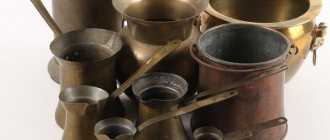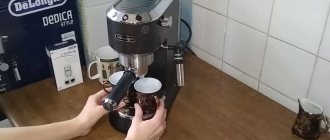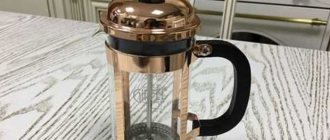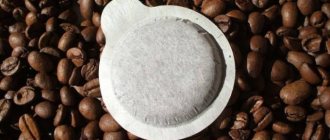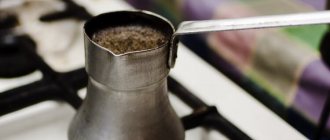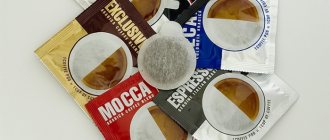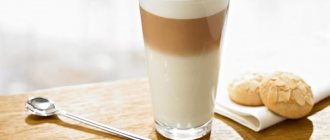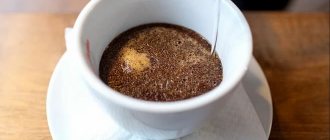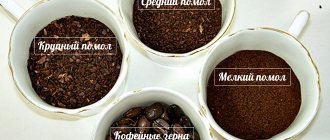Today, not many people brew their own coffee, but in vain. After all, it is known that although the process takes more time, the most delicious coffee is still obtained when brewed in a Turk, and not in a coffee maker or coffee machine. True, for this you need to have a certain skill, since it is with an independent approach to preparing the drink that it is easiest to spoil it. The taste is also affected by the Turk itself that will be used. You can buy many different models of this cookware in stores. But before going there, it would be useful to stock up on the necessary information about what exactly you should pay attention to when purchasing. Our guide will help you make the right choice.
The best coffee machines
Coffee grinders
Drip coffee makers
Carob coffee makers
Geyser coffee makers
A good coffee pot - what should it be like?
To determine which Turk is better, you need to know the characteristics of suitable coffee utensils. This is what a good Turk looks like.
- Cone shape.
- Thick bottom.
- The material used has good thermal conductivity.
- The ratio of neck and bottom is 1:2. The greater this difference, the tastier the coffee.
- Handle made of heat-insulating material.
- Convenient volume.
- Easy to use.
- Reliable to use.
Which Turks best fit this ideal portrait?
Rating of the best manufacturers
The best Turks for making espresso are produced by the following companies:
- Ceraflame;
- Tima;
- Taller;
- Cilio.
In comparison, to these brands we can add Russian manufacturers, who also produce high-quality products for brewing a velvety drink. These include:
- Amphora;
- Loire;
- Stanitsa.
The popularity of manufacturers is due to the high quality and wide range of models. The rating of quality Turks for 2022 will help you make the right choice and understand which company is better to buy a product.
What material is the best Turk?
The material of manufacture is the most basic parameter by which modern cezves differ. Which Turk is better - copper, ceramic, or maybe glass?
Aluminum Turk
For its manufacture, various grades of food grade aluminum alloys are used. The dishes are made by industrial stamping.
pros
- Easy. Aluminum alloy is a lightweight metal.
- Cheap. You can buy it for 200 rubles.
- Reliable. Doesn't break or break.
- Easy to care for. Does not require special operating conditions.
Minuses
- Minimum difference between the diameters of the neck and bottom. Even in the best samples, the required proportion of 1:2 is rarely observed. This leads to loss of aroma of the finished drink.
- Softness of metal. Aluminum is easy to scratch, bend or leave a dent on the body of the Turk.
- Budget design. Turks made of aluminum are unlikely to please with any special sophistication.
- Poor stability due to low weight.
An aluminum pot is good for making coffee on the go.
Copper (brass) Turk
It is made from copper alloys, most often from brass. On sale you can find mass-produced and hand-made products. Turks made of copper without impurities are much less common, because in its pure form the metal oxidizes too quickly, forming compounds that are unsafe for humans. But even brass cezves that are resistant to water and air must be coated with food-grade tin on the inside to prevent the slightest oxidation.
pros
- Cone shape
- Compliance with the required proportions of the bottom and neck. Therefore, the foam that forms during cooking reliably clogs the narrow neck. This preserves the aroma and taste of the drink.
- The thickened bottom promotes uniform heating of the vessel and uniform extraction of coffee powder.
- Reliability.
- Strength.
- Aesthetic appearance.
- Relatively affordable price. A copper Turk can be bought within 700-1000 rubles.
Minuses
- The need for periodic cleaning of the copper Turk.
- The walls of the Turk absorb odors well, especially with prolonged use.
The copper Turk is a classic example of coffee utensils that has proven its effectiveness over hundreds of years of history of its use.
Ceramic (clay) Turk
They are made from a mixture of clay, sometimes with the addition of plasticizers.
You can find handicraft and industrial clay Turks, glazed or without a protective coating. pros
- Environmentally friendly.
- Thick walls promote slow, smooth heating and uniform extraction of coffee powder.
- Variety of designs.
- Cone shape.
- Narrow neck and widened bottom in compliance with the required proportions.
Minuses
- Fragility.
- Instability to shock loads.
- The price is higher than copper and aluminum.
- Excessive decoration is common, which creates problems in daily care.
- Unglazed Turks have increased porosity, so they quickly absorb coloring pigments and odors.
The main advantage of ceramic Turks is its complete safety and environmental friendliness.
Glass Turk
Glass cezves began to be made not so long ago. They use borosilicate glass, which is heat resistant. They are made in factory conditions.
pros
- Aesthetically attractive appearance.
- Ability to control the coffee preparation process.
- Low price. Dishes with a volume of 500 ml can be bought for 350-550 rubles.
- Easy to maintain and use.
- Versatility of use. In a glass ladle you can heat water, milk, even cook soup if necessary.
Minuses
- Fragility
- Large volumes. Glassware for coffee is usually available with a capacity of 0.5 liters or more.
- Water boils too quickly. The required degree of extraction of coffee powder is achieved only by boiling coffee in a glass container, and this destroys the aroma and taste of the drink.
- A departure from the classic form. A neck that is too wide contributes to the loss of aroma and taste when brewing coffee.
The glass cezve looks stylish and modern, but is more suitable as a kitchen ladle for all occasions.
Silver Turk
Products made of silver of different standards often act as a gift or a memorable souvenir. They are produced in workshops or jewelry factories.
pros
- Beauty and grace.
- Classic cone shape with a narrow neck.
- Reliability.
Minuses
- High price.
- Special operating conditions and the need for regular cleaning.
- Excessive decorativeness. Not everyone is ready to use a cezve that costs 25 thousand rubles and more as a household appliance.
- Heats up too quickly. Silver has a very high thermal conductivity, much higher than that of copper and aluminum, so the water in such dishes will boil too quickly, and the coffee will be watery.
A silver Turk is a good and expensive gift, a design element, but it is not suitable for practical use.
Stainless steel Turk
Another product of an industrial society, made of a steel alloy with the addition of chromium or zinc in order to avoid metal oxidation processes. The stainless steel cezve is made in a factory.
pros
- Ease.
- Easy to care for.
- Strength.
- Low price.
- Reliability.
Minuses
- Wide neck.
- Smooth walls and the same metal thickness over the entire surface, without thickening the bottom. This causes the water to boil too quickly, which prevents the coffee powder from being extracted slowly and evenly.
- Large volumes - from 400 ml, but most often dishes are produced in 500 and 750 ml.
Stainless steel cookware can only be called Turkish out of politeness. This steel ladle is durable, convenient and versatile.
A little history
More than 1000 years ago, a drink made from ground coffee beans was brewed over hot coals in copper pots of a regular shape. However, it was difficult to preserve the aroma and taste of coffee in unsuitable containers.
Desert Bedouin nomads carried with them a copper water jug - ibrik (the word comes from the Arabic ibriq or Persian abriz: ab - water and riz - pour). The shape of these vessels: rounded sides, a handle soldered in two places, a wide bottom and a long curved spout - is a little more suitable for making coffee than a kettle, but it is difficult to catch the moment of boiling.
Subsequently, the Arabs created a special vessel for making coffee - dallu (from the Arabic dallah), which is a copper or brass jug with a wide curved spout attached to the top of the vessel, with a lid and handle, like the ibrik. To avoid burning your hands, the handle of the jug was made straight, pointing upward. Dalla is still used to make coffee over an open fire.
Dallah - the prototype of the modern Turkish coffee pot
We owe the appearance of the cezve to the desire of the courtiers of Suleiman the Magnificent to please their master. After the governor of Yemen, Ozdemir Pasha, brought coffee beans as a gift to the Sultan in the mid-16th century, there was a need to change the utensils for brewing coffee.
At first, the drink was prepared for the ruler of the Ottoman Empire in a golden saucepan. However, even in a container made of noble metal, coffee did not turn out as aromatic and tasty as in a forged copper vessel with a narrowed neck, wide bottom and thick walls, called a “cezve”.
Together with the recipes of Eastern coffee masters, this simple vessel spread throughout the world and received a second name - Turk. Over time, the shape changed a little, different materials were used: metals, ceramics. In addition to ordinary cezves, which require a gas or electric stove, or, in extreme cases, a fire, electrical appliances have appeared in which you can also brew delicious coffee.
What size pot is better?
The display cases contain products of completely different sizes. The design of the cezve gives the best results with maximum filling of the dishes. Therefore, it is best to buy a Turk of the size that you usually cook.
- A 100-150 ml cezve is the choice for individual preparation of 1 cup of coffee. It is also used for sand coffee recipe.
- The most popular Turkish format is 350 ml. It holds two cups of drink, so it is ideal for a coffee-loving couple.
- A 500 ml Turk is the best choice for a large family where 3-4 adults drink coffee.
- A 750 ml cezve is purchased for a company or a large family coffee drink.
Turks with a volume of 250-350 ml are in greatest demand. This size is considered universal.
Tips for choosing
To choose a really good Turk for brewing real coffee, you should consider a few tips:
- If the drink is intended for one person, there is no need to consider products with a volume of more than 100 ml.
- You can prepare coffee with a rich taste only in a classic cone-shaped Turk.
- The thinner the walls of the product, the faster the liquid will heat up, and the less quality the drink will be.
- For those who hardly know how to use a Turk and are looking for a universal option, copper, brass, and cupronickel models are suitable.
- True gourmets should pay attention to high quality ceramic or clay products.
- The more securely the handle is attached, the longer the cezve will last.
- The minimum number of decorative elements is the key to easy maintenance.
When buying a Turk, you also need to take into account the type of stove. Induction and glass-ceramic models require a special approach to the selection of cookware and household appliances.
Turk with which handle is better
The main process takes place in the body of the cezve, but a comfortable and strong handle is an important factor in ease of use. Which handle for a Turk will be the most suitable?
Material of manufacture
- Metal. Such handles are usually found in cheap aluminum bowls. Metal holders heat up quickly, so be sure to use oven mitts for them.
- Tree. Handles for copper and sometimes ceramic Turks are made from it. The wood does not heat up and allows you to take dishes with an unprotected hand.
- Plastic. Nowadays the so-called bakelite is popular. It does not heat up, does not melt, and is lightweight. It is from this that holders for glass and steel Turks are made. Sometimes it is used for copper cookware.
Fastening
- Bolted on. In this case, the holder is attached to the body using two bolts, their heads are visible on the inside of the Turk. The fastening is reliable, lasts a long time and has proven itself well.
- On the solder. Soldered handles are less reliable. Modern Turks are coated with various compounds to prevent them from oxidizing. These compounds sometimes interfere with the quality of adhesion during soldering. Therefore, handles soldered to the Turk may fail at the most inopportune moment.
It is best to have a Turk with a wooden or bakelite handle secured with bolts.
What design of Turk is better?
Each user decides this question himself, based on individual tastes. But there are points that you need to remember when choosing the best Turk.
- Dark-colored cezves retain their elegant appearance longer. Even copper Turks are sometimes made with a patina effect so that the darkening that is inevitable over time is not so noticeable.
- The abundance of decorative elements - modeling, appliqués, overlays - may make the Turk more elegant, but makes it difficult to care for her daily. The fewer depressions and depressions on the surface, the easier it is to clean.
- Regular heating can weaken the fastening of applied decors, so it is better to choose a Turk without such elements. The metal surface can be decorated with shallow embossing or engraving, which is easy to clean even when darkened.
